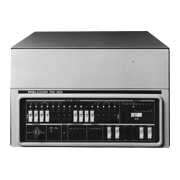These Mitsubishi Electric machines, announced in 1976, were the first Japanese-made minicomputers to use bipolar LSI in their central processing unit. They employed the microprogram system, and used bipolar LSI with a 4-bit slice for the arithmetic control section, and 1 Kbit bipolar ROM for control memory. For main memory, these machines used 4 Kbit NMOS LSI with a 16-bit word and one parity bit, and cycle time was 0.5µ s.
Maximum main memory capacity was 32 Kword for the Model 20, 64 Kword for the Model 25, and 128 Kword for the Model 35. The Model 35 used an address conversion mechanism (employing a boundary register and relocation register) to enable access of a large physical address space by using a 16-bit logical address space. An expansion logical address space (16-bit) specifically for data was available, and this enabled use of a maximum 128 Kword main memory by a single program.
The system also featured comprehensive RAS design, added capabilities such as bit processing and byte processing instructions, faster floating point arithmetic using firmware, use of input/output channels, and an extended debugging mechanisms.
As basic software, Mitsubishi Electric completed a software system called MARCS70 (MELCOM70 All Round Adaptive Consolidated Software System) to support online systems, real-time systems and batch processing for applications such as scientific and engineering computation, and this was provided as a flexible OS for this "paper tape free minicomputer".


